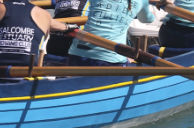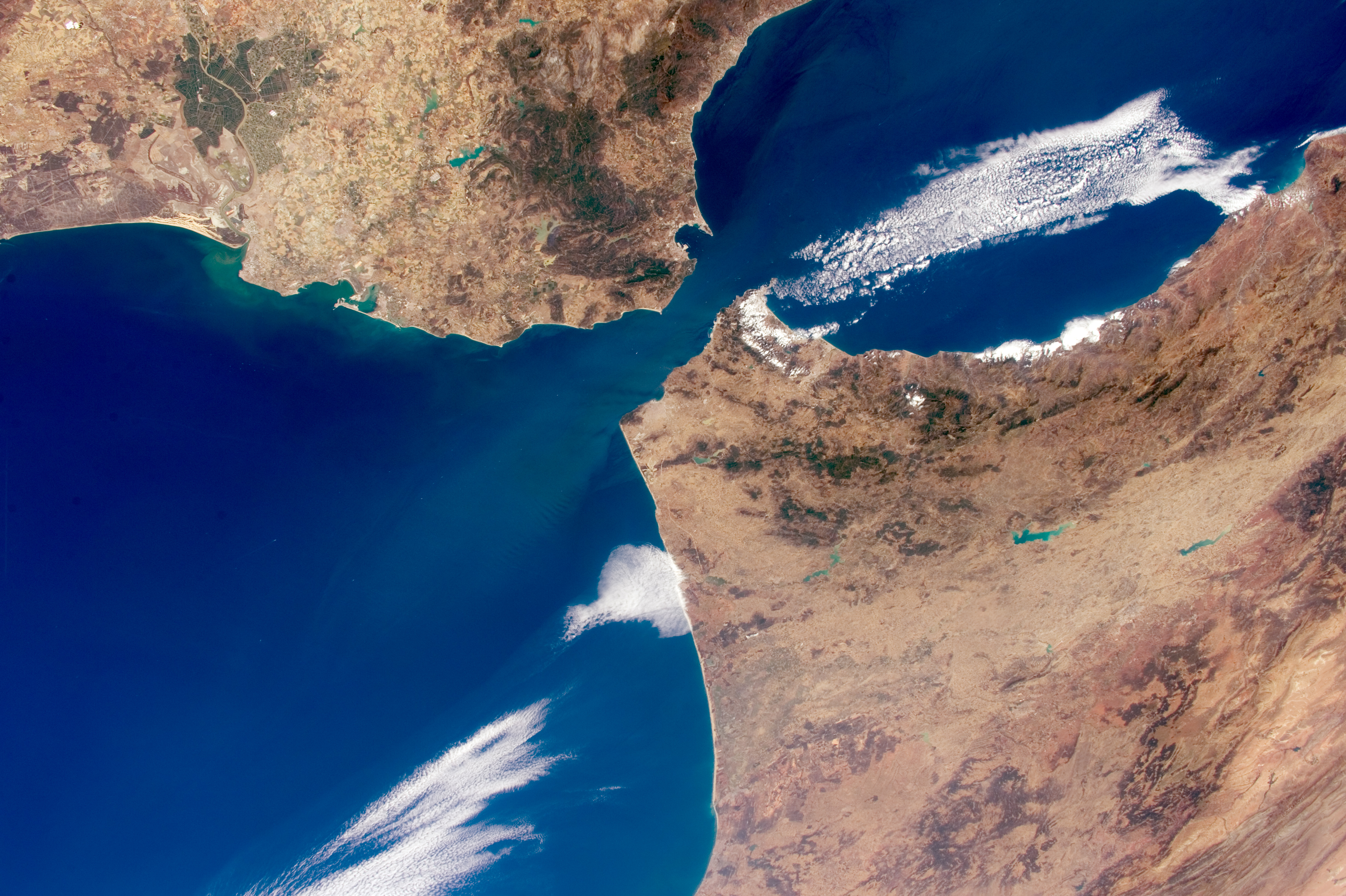|
Rowlocks
A rowlock (), sometimes spur (due to the similarity in shape and size), oarlock (American English) or gate, is a brace that attaches an oar to a boat. When a boat is rowed, the rowlock acts as a fulcrum for the oar. On ordinary rowing craft, the rowlocks are attached to the gunwales. In the sport of rowing, the rowlocks are attached to outriggers (often just called "riggers"), which project from the boat and provide greater leverage. In sport rowing, the rowlocks are normally U-shaped and attached to a vertical pin which allows the rowlock to pivot around the pin during the rowing stroke. They additionally have a locking mechanism (properly known as "the gate") across the top of the "U" to prevent the oar from unintentionally popping out of the rowlock. In some, largely older, strict terminologies, a rowlock is a U-shaped cut-out in the top strake of a boat (usually the wash-strake). In older texts, the U-shaped metal fitting may be called an "oar crutch", a usage which is ... [...More Info...] [...Related Items...] OR: [Wikipedia] [Google] [Baidu] |
Rowing Sport Oarlock
Rowing is the act of propelling a human-powered watercraft using the sweeping motions of oars to displace water and generate reactional propulsion. Rowing is functionally similar to paddling, but rowing requires oars to be mechanically attached to the boat, and the rower drives the oar like a lever, exerting force in the ''same'' direction as the boat's travel; while paddles are completely hand-held and have no attachment to the boat, and are driven like a cantilever, exerting force ''opposite'' to the intended direction of the boat. In some strict terminologies, using oars for propulsion may be termed either "pulling" or "rowing", with different definitions for each. Where these strict terminologies are used, the definitions are reversed depending on the context. On saltwater a "pulling boat" has each person working one oar on one side, alternating port and starboard along the length of the boat; whilst "rowing" means each person operates two oars, one on each side of the ... [...More Info...] [...Related Items...] OR: [Wikipedia] [Google] [Baidu] |
Rowing
Rowing is the act of propelling a human-powered watercraft using the sweeping motions of oars to displace water and generate reactional propulsion. Rowing is functionally similar to paddling, but rowing requires oars to be mechanically attached to the boat, and the rower drives the oar like a lever, exerting force in the ''same'' direction as the boat's travel; while paddles are completely hand-held and have no attachment to the boat, and are driven like a cantilever, exerting force ''opposite'' to the intended direction of the boat. In some strict terminologies, using oars for propulsion may be termed either "pulling" or "rowing", with different definitions for each. Where these strict terminologies are used, the definitions are reversed depending on the context. On saltwater a "pulling boat" has each person working one oar on one side, alternating port and starboard along the length of the boat; whilst "rowing" means each person operates two oars, one on each side of ... [...More Info...] [...Related Items...] OR: [Wikipedia] [Google] [Baidu] |
Rowing (sport)
Rowing, often called crew American English, in the United States, is the sport of racing boats using Oar (sport rowing), oars. It differs from paddling sports in that rowing oars (called blades in the United Kingdom) are attached to the boat using Rowlock, rowlocks, while paddles are not connected to the boat. Rowing is divided into two disciplines: sculling and sweep rowing. In sculling, each rower (or oarsman) holds two oars, one in each hand, while in sweep rowing each rower holds one oar with both hands. There are several boat classes in which athletes may compete, ranging from single sculls, occupied by one person, to shells with eight rowers and a coxswain (rowing), coxswain, called eight (rowing), eights. There are a wide variety of course types and formats of racing, but most elite and championship level racing is conducted on calm water courses long with several lanes marked using buoys. Modern rowing as a competitive sport can be traced to the early 17th century whe ... [...More Info...] [...Related Items...] OR: [Wikipedia] [Google] [Baidu] |
Gunwale
The gunwale () is the top edge of the hull of a ship or boat. Originally the structure was the "gun wale" on a sailing warship, a horizontal reinforcing band added at and above the level of a gun deck to offset the stresses created by firing artillery. Over time it remained as a valuable stiffener mounted inboard of the sheer strake on commercial and recreational craft. In modern boats, it is the top edge of the hull where there is usually some form of stiffening, often in the form of traditional wooden boat construction members called the "inwale" and "outwale". On a canoe, the gunwale is typically the widened edge at the top of its hull, reinforced with wood, plastic or aluminum, to carry the thwarts. On a narrowboat A narrowboat is a particular type of Barge, canal boat, built to fit the narrow History of the British canal system, locks of the United Kingdom. The UK's canal system provided a nationwide transport network during the Industrial Revolution, b ... or ... [...More Info...] [...Related Items...] OR: [Wikipedia] [Google] [Baidu] |
Coat Of Arms
A coat of arms is a heraldry, heraldic communication design, visual design on an escutcheon (heraldry), escutcheon (i.e., shield), surcoat, or tabard (the last two being outer garments), originating in Europe. The coat of arms on an escutcheon forms the central element of the full achievement (heraldry), heraldic achievement, which in its whole consists of a shield, supporters, a crest (heraldry), crest, and a motto. A coat of arms is traditionally unique to the armiger (e.g. an individual person, family, state, organization, school or corporation). The term "coat of arms" itself, describing in modern times just the heraldic design, originates from the description of the entire medieval chainmail "surcoat" garment used in combat or preparation for the latter. Roll of arms, Rolls of arms are collections of many coats of arms, and since the early Modern Age centuries, they have been a source of information for public showing and tracing the membership of a nobility, noble family, a ... [...More Info...] [...Related Items...] OR: [Wikipedia] [Google] [Baidu] |
Strait
A strait is a water body connecting two seas or water basins. The surface water is, for the most part, at the same elevation on both sides and flows through the strait in both directions, even though the topography generally constricts the flow somewhat. In some straits there is a dominant directional current. Most commonly, the strait is a narrowing channel that lies between two land masses. Straits are loci for sediment accumulation, with sand-size deposits usually occurring on the two strait exits, forming subaqueous fans or deltas. Some straits are not navigable because, for example, they are too narrow or too shallow, or because of an unnavigable reef or archipelago. Terminology The terms '' channel'', ''pass'', or ''passage'' can be synonymous and used interchangeably with ''strait'', although each is sometimes differentiated with varying senses. In Scotland, '' firth'' or ''Kyle'' are also sometimes used as synonyms for strait. Many straits are economically impor ... [...More Info...] [...Related Items...] OR: [Wikipedia] [Google] [Baidu] |
Hankasalmi
Hankasalmi is a municipality of Finland, located in the Central Finland region. The municipality has a population of () and covers an area of of which is water. The population density is . The municipality is unilingually Finnish. Hankasalmi is the only authentic rural municipality in Jyväskylä, that offers its inhabitants and guests a wide range of opportunities in the housing, work and leisure sectors. Comprehensive services and good transport links by highway and rail ensure smooth handling. Hankasalmi has several elementary schools, a high school, and a high school where you can take part in high-level navigation training. Geography Neighbouring municipalities are Kangasniemi, Konnevesi, Laukaa, Pieksämäki, Rautalampi and Toivakka. There are all together 97 lakes in Hankasalmi. The biggest lakes are Kynsivesi-Leivonvesi, Armisvesi and Kuuhankavesi. Villages * Halttula History The name Hankasalmi was first mentioned in 1552 when it was a wilderness o ... [...More Info...] [...Related Items...] OR: [Wikipedia] [Google] [Baidu] |
Canting Arms
Canting arms are heraldry, heraldic bearings that represent the bearer's name (or, less often, some attribute or function) in a visual pun or rebus. The expression derives from the latin ''cantare'' (to sing). French heralds used the term (), as they would sound out the name of the armiger. Many armorial allusions require research for elucidation because of changes in language and dialect that have occurred over the past millennium. Canting arms – some in the form of rebuses – are quite common in German civic heraldry. They have also been increasingly used in the 20th century among the British royal family. When the visual representation is expressed through a rebus, this is sometimes called a ''rebus coat of arms''. An in-joke among the Society for Creative Anachronism heralds is the pun, "Heralds don't pun; they cant." Examples of canting arms Personal coats of arms A famous example of canting arms are those of Queen Elizabeth The Queen Mother's paternal family, th ... [...More Info...] [...Related Items...] OR: [Wikipedia] [Google] [Baidu] |
Argent
In heraldry, argent () is the tincture of silver, and belongs to the class of light tinctures called "metals". It is very frequently depicted as white and usually considered interchangeable with it. In engravings and line drawings, regions to be tinctured ''argent'' are either left blank, or indicated with the abbreviation ''ar''. The name derives from Latin ''argentum'', translated as "silver" or "white metal". The word ''argent'' had the same meaning in Old French ''blazon'', whence it passed into the English language. In some historical depictions of coats of arms, a kind of silver leaf was applied to those parts of the device that were argent. Over time, the silver content of these depictions has tarnished and darkened. As a result, it can sometimes be difficult to distinguish regions that were intended as "argent" from those that were " sable". This leaves a false impression that the rule of tincture has been violated in cases where, when applied next to a dark colour, a ... [...More Info...] [...Related Items...] OR: [Wikipedia] [Google] [Baidu] |
Azure (heraldry)
In heraldry, azure ( , ) is the tincture (heraldry), tincture with the colour azure (color), blue, and belongs to the class of tinctures called "colours". In engraving, it is sometimes depicted as a region of horizontal lines or else is marked with either az. or b. as an abbreviation. The term azure shares its origin with the Spanish word "azul", which refers to the same color, deriving from Hispanic Arabic ''lāzaward'', the name of the deep blue stone now called lapis lazuli. The word was adopted into Old French by the 12th century, after which the word passed into use in the blazon of coat of arms, coats of arms. As a heraldic colour, the word azure means "blue", and reflects the name for the colour in the Anglo-Norman language, Anglo-Norman dialect spoken by French-speaking Norman nobles following the Norman Conquest of England. A wide range of colour values is used in the depiction of azure in armory and flags, but in common usage it is often referred to simply as "blue". ... [...More Info...] [...Related Items...] OR: [Wikipedia] [Google] [Baidu] |



